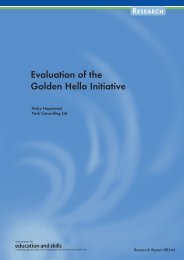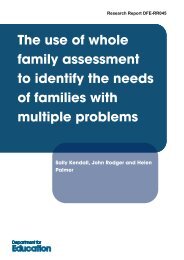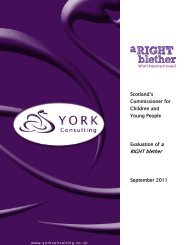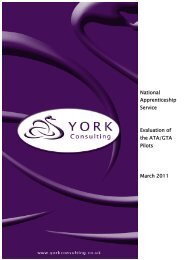Recruitment and Retention in the Post-16 Learning and Skills Sector
Recruitment and Retention in the Post-16 Learning and Skills Sector
Recruitment and Retention in the Post-16 Learning and Skills Sector
Create successful ePaper yourself
Turn your PDF publications into a flip-book with our unique Google optimized e-Paper software.
6.24 Respondents were asked <strong>the</strong> broad reasons for consider<strong>in</strong>g leav<strong>in</strong>g <strong>the</strong>ircurrent employment (Table 6.3). Over half of those consider<strong>in</strong>g achange of job (57%) <strong>in</strong>dicated that this was to pursue a job <strong>in</strong> a relatedsector with<strong>in</strong> education. 34% had considered a job <strong>in</strong> a completelydifferent sector <strong>and</strong> 9% had considered early retirement.Table 6.3: Reason for consider<strong>in</strong>g leav<strong>in</strong>g current job.% of those who consideredleav<strong>in</strong>gA different job <strong>in</strong> <strong>the</strong> same organisation 7A job <strong>in</strong> a related sector (with<strong>in</strong> education) 57A job <strong>in</strong> a completely different sector 34Early retirement 9O<strong>the</strong>r 5Don’t know 1Base: 2330 respondents, who have considered leav<strong>in</strong>g <strong>the</strong>ir jobSource: YCL/MORI quantitative survey of teach<strong>in</strong>g/tra<strong>in</strong><strong>in</strong>g staff, 20056.25 Qualitative evidence from face to face <strong>in</strong>terviews with staff providefur<strong>the</strong>r detail <strong>and</strong> support many of <strong>the</strong> f<strong>in</strong>d<strong>in</strong>gs from <strong>the</strong> quantitativestudy:• a small number <strong>in</strong>tend to leave post-<strong>16</strong> teach<strong>in</strong>g/tra<strong>in</strong><strong>in</strong>g <strong>in</strong> <strong>the</strong> nearfuture;• older staff aged over 50 hope to see out <strong>the</strong> rema<strong>in</strong><strong>in</strong>g years of<strong>the</strong>ir work<strong>in</strong>g life <strong>in</strong> <strong>the</strong>ir present jobs, “I will stay at <strong>the</strong> college untilI retire at age 60 <strong>in</strong> three years time” [Fur<strong>the</strong>r Education];• some staff <strong>in</strong>dicated <strong>the</strong>y may move between <strong>the</strong> sub-sectors butgenerally expected to stay with<strong>in</strong> <strong>the</strong> post-<strong>16</strong> learn<strong>in</strong>g <strong>and</strong> skillssector.6.26 The chart below presents <strong>the</strong> f<strong>in</strong>d<strong>in</strong>gs by pr<strong>in</strong>cipal job activity (Figure6.7). A greater proportion of managers (15%) <strong>and</strong> teachers/tra<strong>in</strong>ers(14%) had applied for o<strong>the</strong>r jobs with<strong>in</strong> <strong>the</strong> last six months than learn<strong>in</strong>gsupport workers (12%) <strong>and</strong> assessors (13%).58











